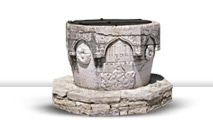
- Sečovlje Salt Pans - Dragonja River Valley
- Sv. Peter - Nova vas - Padna
- Pomjan - Nature Park: Karst Edge - Socerb
- Črni Kal - Osp - Kubed
- Momjan - Grožnjan - Pietrapelosa - Mirna
- Baštija - Kostanjica - Parenzana
- Oprtalj - Završje - Livade - Zrenj
- Istarske toplice - Motovun Forest - Višnjan
- Cave Mramornica - Feštini Kingdom - Cave Baredine
- Lim Bay - Kloštar - Kontija - Dvigrad
- Kanfanar - Bale - Palud - Vodnjan -Islands Brijuni - Fažana
- Svetvinčenat - Tinjan - Pićan - Gračišće
- Belaj - Šumber - Kožljak - Paz
- Čepićko Field - Kršan - Boljun Castle - Lupoglav
- Plomin - Kvarner Gulf - Brseč
- Nature park Učka - Mošćenice
Pomjan - Nature Park: Karst Edge - Socerb
Socerb
Overlooking the Gulf of Trieste, Socerb Castle, built on the ruins of an Illyrian hill-fort, has for centuries withstood the northern wind bora and ravages of time. It was first mentioned in 1040, and was named after the patron saint of Trieste and martyr, St. Servul (St. Socerb, San Servolo). According to legend, after converting to Christianity Servul hid in the nearby cave (283 or 284) before the governor of Trieste had him executed.
In the past, the castle had a significant strategic position, controlling the political border and important routes, so it was the reason for battles between the Venetians and people of Trieste. In the early medieval period residential areas were added, so that it grew into a fortification with permanently resident troops. However, in the second half of the 14th c. the town nobles withdrew from their knightly life and turned to more profitable sources of income. After the peace agreement, the fortification was transformed into a landed property. Territories of the ancient ager of Trieste and villages that had been taken away long before, were joined to it. In spite of the renowned wine from the surrounding vineyards, the owners fell into debts and were forced to sell the property. This was followed by fires, devastation, selling and change of owners and finally in 1925, reconstruction. The present appearance of the castle differs greatly from the description of the historian and travel writer Valvasor in The Glory of the Duchy of Carniola (Slavi vojvodine Kranjske). He also gives a detailed account of the Holy Cave, the only subterranean church in the world, where a mass in honor of St. Servul is held every May.
Print page Send to a friend

















